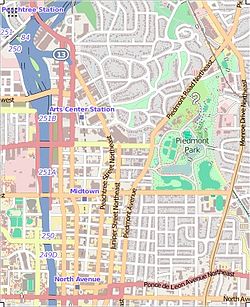Habersham Memorial Hall
Habersham Memorial Hall | |
 Habersham Memorial Hall (2014) | |
| Location | 270 15th Street Atlanta, Georgia, United States |
|---|---|
| Coordinates | 33°47′19″N 84°22′41″W / 33.78861°N 84.37806°W |
| Built | 1922 |
| Architect | Henry Hornbostel |
| Architectural style | Federal |
| NRHP reference No. | 74000676 |
| Added to NRHP | June 7, 1974 |
Habersham Memorial Hall is a historic building in Atlanta, Georgia, United States. The building, named in honor of Joseph Habersham, was designed by Henry Hornbostel to serve as the headquarters for the local chapter of the Daughters of the American Revolution. The building was constructed between 1922 and 1923 and was added to the National Register of Historic Places in 1974.
History
On February 12, 1900, the Joseph Habersham Chapter of the National Society Daughters of the American Revolution was organized at the Georgia Governor's Mansion, with the wife of Georgia Governor Allen D. Candler serving as one of its founders. The chapter, based in Atlanta, was named in honor of Joseph Habersham, a politician from Georgia who had been a soldier in the Continental Army during the American Revolutionary War and served as the United States Postmaster General, among other government positions.[1] On January 14, 1922, the cornerstone for a new headquarters for the chapter was laid, with the building's construction completed the following year.[1] According to the chapter, the building was erected "as a memorial to the Heroes of all Wars in which Georgia has participated."[2] Henry Hornbostel served as the architect for the building, which was designed as a replica of the Bulloch–Habersham House in Savannah, Georgia.[3] Designed by William Jay in 1819, that house had been demolished in 1916.[4] In April 1923, the hall hosted the 25th annual state conference of the Georgia Daughters of the American Revolution.[2][5]
On June 7, 1974, the building was added to the National Register of Historic Places.[6] That same year, a Georgia historical marker was erected near the building.[1]
Architecture
The building has a frontage of 200 feet (61 m).[2] The front of the 2 story building features French doors underneath a hexastyle portico directly beneath the gable.[3] The columns of the portico are of the composite order, blending elements of Ionic and Corinthian columns.[4] The windows on the second story feature guard rails made of cast iron.[3] The brick exterior of the building was previously covered with a white stucco that has since been removed, giving the exterior a slight patina.[4] The Bulloch–Habersham House, of which this building is a replica of, was built in the Federal style.[3]
See also
References
- ^ a b c "Habersham Memorial Hall". Georgia Historical Society. November 4, 2015. Retrieved October 25, 2020.
{{cite web}}: CS1 maint: url-status (link) - ^ a b c Clarke, Christian H. (March 1924). "Joseph Habersham Chapter". Daughters of the American Revolution Magazine. LVIII (3): 185–186 – via Google Books.
- ^ a b c d The National Register of Historic Places, 1976. National Park Service. 1976. p. 166 – via Google Books.
- ^ a b c Lee, Conor (June 13, 2013). "Habersham Memorial Hall". History Atlanta. Retrieved October 25, 2020.
{{cite web}}: CS1 maint: url-status (link) - ^ Peacock, Anne Boisfeuillet (December 1923). "Georgia". Daughters of the American Revolution Magazine. LVII (12): 735–736 – via Google Books.
- ^ "National Register of Historic Places". Federal Register. 42 (21). Office of the Federal Register: 6225. February 1, 1977 – via Google Books.
External links
 Media related to Habersham Memorial Hall at Wikimedia Commons
Media related to Habersham Memorial Hall at Wikimedia Commons- The National War Memorial Registry
- Historical Marker Database




